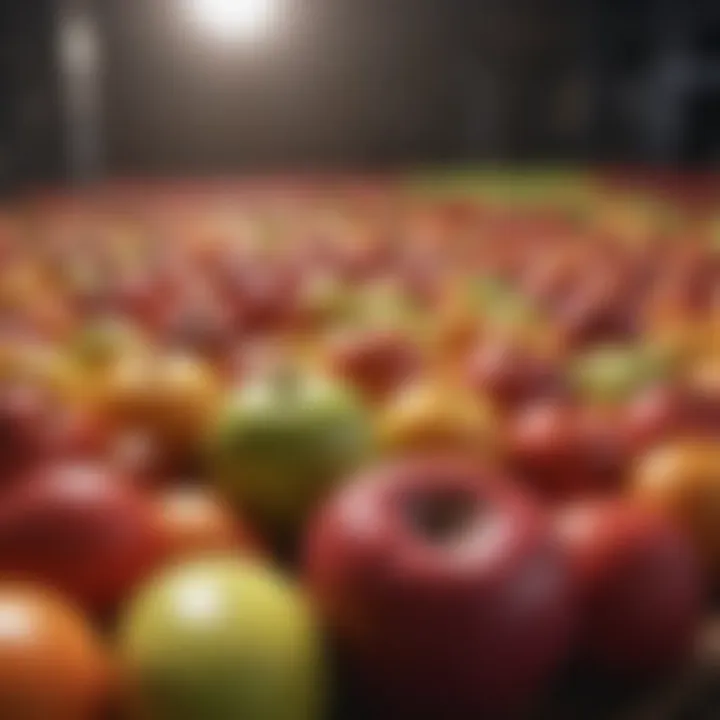The Role of Ethylene in Fruit Ripening and Agriculture


Intro
Ethylene is a small gaseous hormone, yet its impact on fruit ripening is profound and complex. Understanding its mechanisms is not only essential for improving agricultural practices but also crucial for enhancing food quality. Ethylene plays a major role in the biochemical processes that govern ripening, signaling, and even senescence in fruits. This article seeks to unravel the complexities of ethylene's influence on fruit maturation and the far-reaching implications for both the agricultural sector and food science at large.
Recent Advances
Recent years have witnessed significant progress in understanding the role of ethylene in fruit ripening. This section will explore key discoveries and technological innovations that have emerged in this field.
Latest Discoveries
Researchers have identified specific receptors involved in ethylene perception. These discoveries have clarified how different fruits respond to ethylene, leading to variations in ripening times and processes. For instance, studies have shown that climacteric fruits, such as bananas and tomatoes, experience a surge in ethylene production that triggers ripening, while non-climacteric fruits do not exhibit such a response. This knowledge is reshaping our understanding of how to manage ripening in various fruit types more effectively.
Moreover, advancements in genomics have resulted in the identification of genes that are directly related to ethylene synthesis and response. The elucidation of the ethylene biosynthesis pathway has opened new doors for genetic manipulation and breeding techniques aimed at improving fruit quality and shelf-life.
Technological Innovations
The application of ethylene in industry continues to evolve. Technologies involving controlled atmosphere storage and ripening chambers have become common in post-harvest management. These innovations allow producers to regulate ethylene levels precisely, thereby extending shelf life and maintaining freshness during transport.
Recent developments in ethylene-sensing technologies have also emerged, facilitating real-time monitoring of ethylene levels during storage and transit. This ensures optimal ripening conditions, ultimately enhancing both profitability and consumer satisfaction.
Methodology
A structured approach is necessary to investigate the multifaceted role of ethylene in fruit ripening. This section outlines the research designs employed to gather and analyze relevant data.
Research Design
Most studies investigating ethylene's role in fruit ripening utilize experimental setups that combine field trials with controlled laboratory experiments. These designs enable researchers to observe fruit behavior under various environmental conditions and ethylene concentrations. Typically, these studies compare the physiological responses of climacteric and non-climacteric fruits when exposed to ethylene gas.
Data Collection Techniques
Data collection often employs techniques like gas chromatography to measure ethylene production and sensitivity. Additionally, molecular analyses help identify the expression levels of genes associated with ethylene production and response in various fruit types. This rigorous approach offers a comprehensive understanding of ethylene's impacts across different species.
Ethylene governs important physiological processes that are vital for fruit quality, from stimulating ripening to influencing flavor development.
Understanding ethylene's role in fruit ripening gives valuable insights for agricultural practices. Enhancements in techniques and methodologies continue to pave the way to more effective and efficient strategies for managing fruit quality, storage, and distribution.
As the body of research grows, it becomes increasingly evident that ethylene not only serves as a hormone but also as a key player in the agricultural landscape. Its implications extend well beyond the ripening of fruit.
Understanding Ethylene
Ethylene plays a crucial role in the process of fruit ripening. It is a gaseous plant hormone that significantly influences various physiological processes. Understanding ethylene is essential for several reasons. First, it directly affects the ripening process, determining when a fruit becomes edible. Second, its presence or absence can influence the quality and shelf-life of fruits. Knowing more about ethylene allows researchers, farmers, and food manufacturers to optimize ripening conditions, thereby ensuring better quality produce.
Chemical Structure and Properties
Ethylene is a simple hydrocarbon with the chemical formula C2. It consists of two carbon atoms double-bonded to each other, with each carbon also bonded to two hydrogen atoms. This structure gives ethylene its gaseous state at room temperature, making it one of the simplest organic compounds. Due to its gaseous nature, ethylene can easily diffuse through plant tissues and surrounding environments, affecting nearby fruits and plants.
A notable property of ethylene is its role as a signaling molecule. It can trigger various biochemical pathways in fruits. Ethylene's interaction with fruit cells leads to physiological changes, including the degradation of chlorophyll, which is responsible for a fruit's green color. Additionally, it promotes the softening of cell walls, making fruits easier to eat.
Historical Background
The scientific exploration of ethylene dates back to the 19th century. The first significant research in this area was conducted in 1864 by the chemist Sir Henry Gilbert, who found that ethylene could accelerate the ripening of fruits. This discovery led to further research over the years, establishing the compound as a key regulator of the ripening process.
By the mid-20th century, scientists recognized ethylene's potential in agriculture. In 1934, researchers identified that the gas played a crucial role in the ripening of bananas. This knowledge initiated the commercial application of ethylene in the agriculture industry, leading to techniques for controlling fruit ripening. As understanding grew, ethylene was applied more broadly in post-harvest technologies, shaping modern practices in fruit storage and distribution.
Overall, understanding the chemical structure and historical significance of ethylene provides a foundation for appreciating its role in fruit ripening and its implications in agriculture.
The Biochemistry of Ethylene
Understanding the biochemistry of ethylene is crucial for unraveling its role in the complex process of fruit ripening. Ethylene is not only a plant hormone but also a key regulator that triggers physiological responses leading to ripening. The manipulation of ethylene production can have significant implications in agricultural practices, including storage and shelf-life extension of fruits and vegetables. The mechanisms by which this compound operates are rooted in its biochemical pathways, which are intricate and multifaceted.
Synthesis of Ethylene
Ethylene synthesis in higher plants primarily occurs through the action of the enzyme 1-aminocyclopropane-1-carboxylic acid (ACC) synthase. The process begins with the conversion of S-adenosylmethionine (SAM) to ACC, which is subsequently converted to ethylene by another enzyme, ACC oxidase. This enzymatic reaction signifies a critical step in the hormone's biosynthesis.
Various environmental and internal signals can influence this synthesis, leading to increased ethylene levels during stress or developmental changes. For instance, factors such as ripening fruit exposure, mechanical injury, and pathogen attack can elevate the ethylene concentration, further promoting ripening processes. It is essential for plant health and food industries to control ethylene levels for optimal ripening.
Signal Transduction Pathways
Ethylene’s impact on fruit ripening extends beyond its synthesis to its signaling mechanisms. The ethylene signaling pathway involves several key components, including receptors, signaling proteins, and transcription factors. Ethylene binds to its receptors located in the endoplasmic reticulum, triggering a cascade of events that results in changes at the genomic level.


Upon binding, a series of degradation of the negative regulators occurs, enabling the transcription factors to activate specific genes related to ripening. This process leads to a variety of physiological and biochemical changes in the fruit, which include:
- Color changes: Such as the conversion of chlorophyll to carotenoids, enhancing the visible color of the ripe fruit.
- Texture softening: The breakdown of cell wall materials like pectin and cellulose, which contributes to the softening texture of ripe fruits.
Through these pathways, ethylene plays a pivotal role in orchestrating the developmental processes that lead to fruit ripening.
Role of Ethylene in Fruit Ripening
Ethylene is a crucial hormone in the ripening of fruits. It regulates a variety of physiological processes that lead to the transformation of fruit from a hard, inedible state to a soft, flavorful product. Understanding the role of ethylene is essential for improving fruit quality and extending shelf life. This article discusses how ethylene influences various changes during ripening, which can directly impact agricultural practices and post-harvest management.
Physiological Changes
Physiological changes induced by ethylene play a significant role in determining fruit quality. These changes can be broadly categorized into two areas: color changes and texture softening.
Color Changes
Color changes in fruits signify ripening and are primarily driven by ethylene. During ripening, chlorophyll breaks down, leading to the exposure of carotenoids and anthocyanins. This change enhances the visual appeal of fruits, making them more attractive to consumers. For instance, the transition from green to a yellow or red hue in fruits like bananas and tomatoes is vital. The advantage of this change is that it indicates ripeness, which can help in marketing strategies. However, excessive ethylene exposure can lead to over-ripening and spoilage, presenting a challenge for retailers and consumers.
Texture Softening
Texture softening is another physiological change that ethylene governs. The hormone influences enzymes like pectinase and cellulase, which break down cell wall components. As a result, fruits become softer and easier to eat. For example, peaches and avocados must achieve a certain softness before they are enjoyable. Softening is beneficial as it enhances the eating quality of fruit. Nonetheless, a downside can be that over-softening may lead to a reduction in shelf life, making careful management of ethylene exposure necessary.
Nutritional Changes
Nutritional changes in fruit during ripening are also significant. Ethylene aids in sugar production and acid degradation, both of which are crucial for establishing the flavor profile of ripe fruit.
Sugar Production
Ethylene stimulates the breakdown of starches into sugars, increasing the sweetness of fruit. The conversion process contributes to the overall flavor, making fruits like mangoes and grapes highly desirable when ripe. The main appeal of sugar production is that it enhances the taste, driving consumer preference. Nevertheless, the correlated increase in sugar levels may conflict with dietary health considerations for some individuals, suggesting a need for balance during post-harvest treatments.
Acid Degradation
Acid degradation is another process facilitated by ethylene, leading to a decrease in sourness as fruits ripen. This process is vital in fruits like apples, where the reduction in citric and malic acids enhances the palatability of the fruit. The advantage of acid degradation is its role in improving the flavor balance; however, it can lead to overripe flavors if not managed correctly. This poses a challenge for producers aiming to optimize fruit quality and flavor.
Ethylene plays an essential role in determining the quality parameters of fruit, including color, texture, and taste, thus significantly influencing marketability and consumer satisfaction.
Ethylene’s Interaction with Other Hormones
The interaction between ethylene and other plant hormones is a crucial aspect of fruit ripening. These interactions can be synergistic or antagonistic, influencing the overall ripening process and the quality of the fruit. Understanding these relationships provides insights into how ripening can be controlled and optimized in agricultural practices.
Synergistic Interactions
Auxins
Auxins are a group of plant hormones that play a significant role in regulating plant growth and development. One of the key aspects of auxins is their ability to promote cell elongation and division. In the context of fruit ripening, auxins support the synthesis and activity of ethylene, creating a positive feedback loop which enhances the ripening process.
The benefits of auxins in fruit ripening include:
- Promotion of Ethylene Production: Auxins stimulate the synthesis of ethylene, thus accelerating the ripening process.
- Fruit Development: They contribute to the development of fruit tissues, ensuring an optimal size and texture.
A unique feature of auxins is their role in regulating other physiological functions, such as phototropism and apical dominance. Their broad effects make them highly beneficial when considering the overall growth and ripening of fruits. However, an excess of auxins can lead to undesired outcomes, such as excessive fruit drop or abnormal growth patterns.
Gibberellins
Gibberellins are another class of plant hormones that significantly affect fruit ripening. They are known primarily for their role in promoting stem elongation and seed germination. In terms of the ripening process, gibberellins work synergistically with ethylene to advance the maturation of fruits. They enhance the production of enzymes that are necessary for ripening, further complementing ethylene's effects.
Key characteristics of gibberellins include:
- Enzymatic Activity Enhancement: They facilitate the breakdown of starches into sugars, contributing to the sweetness of the fruit at maturity.
- Influence on Fruit Size: Gibberellins can lead to an increase in fruit size, which is often desirable for commercial sales.
While gibberellins provide clear benefits, their application must be managed. Overuse can lead to uneven ripening or results that do not align with market standards.
Antagonistic Relationships
Abscisic Acid
Abscisic Acid (ABA) is a hormone that typically acts antagonistically to ethylene. It is predominantly associated with stress responses in plants. One important role of ABA in fruit ripening is to delay the process under adverse conditions, such as drought or low temperature. This feature is vital for ensuring fruit quality, as it can prevent premature ripening before optimal conditions are met.
Key characteristics include:
- Stress Response: ABA helps plants cope with environmental stress, delaying ripening to enhance survival.
- Regulation of Water Loss: It plays a role in closing stomata, thus reducing water loss in fruits, which is beneficial for fruit preservation.


However, the presence of too much ABA can create adverse effects, delaying ripening excessively and affecting marketability.
Ethylene Response Factors
Ethylene Response Factors (ERFs) are transcription factors that regulate gene expression in response to ethylene. They mediate the effects of ethylene on different physiological processes, including fruit ripening. A significant aspect of ERFs is their ability to regulate both ethylene sensitivity and response, establishing a complex relationship in the ripening process.
The key characteristics of ERFs include:
- Gene Regulation: They control the expression of genes involved in various ripening processes, including those for coloration and flavor development.
- Response to Other Hormones: ERFs interact with other hormones, modulating their effects on fruit development.
While ERFs enhance the ripening process, their regulatory interactions can also complicate understanding of how fruit maturity is orchestrated. Therefore, balancing ethylene and ERFs becomes important in agricultural practices.
Common Ethylene-Producing Fruits
Understanding common ethylene-producing fruits is essential for comprehending how ethylene influences ripening processes. These fruits are significant in agriculture and food science, as they serve as prime examples of ethylene's effects. The ability of certain fruits to produce ethylene gas naturally makes them crucial not only for their own ripening but also for those of other fruits around them. This phenomenon is known as climacteric ripening. It vividly illustrates the interconnectedness of plants in their environments.
Fruits like bananas, tomatoes, and apples are vital in our daily diets. They differ in their ripening behaviors, which are largely influenced by ethylene. Knowing these fruits will help in developing better post-harvest management techniques to reduce spoilage and improve quality. Let's delve into these fruits individually to understand their roles and implications.
Bananas
Bananas are among the most recognized climacteric fruits due to their high ethylene production. Ethylene plays a pivotal role in several physiological changes that lead to the ripening of bananas. For instance, the starches in unripe bananas convert to sugars as they ripen. This conversion enhances the sweetness of bananas, making them more palatable.
Additionally, bananas exhibit significant color changes during ripening. The green peel, due to chlorophyll content, transforms to a yellow hue as chlorophyll breaks down and carotenoids become more visible.
"The ripening of bananas illustrates the rapid decomposition of starches into sugars, making them sweet and appealing."
Ethylene not only initiates these changes but also helps in softening the banana's texture. The enzymes activated during this process degrade cell wall components, leading to a softer fruit. This change is essential for consumer acceptance. Therefore, bananas exemplify the critical role of ethylene in fruit ripening and highlight how understanding this gas can lead to improved harvesting and marketing strategies.
Tomatoes
Tomatoes are another prime ethylene-producing fruit. They begin to produce ethylene gas as they reach maturity. The impact of ethylene on tomatoes is profound, particularly in regard to their development of flavor and texture. Ethylene exposure can hasten the ripening process, leading to desired characteristics in tomatoes, such as color and taste.
During ripening, tomatoes change from green to red, a transformation that involves various biochemical reactions. The breakdown of chlorophyll leads to the formation of lycopene, the pigment responsible for the red color. Tomatoes also soften over time due to the breakdown of pectin and cellulose in the cell walls, a process magnified by ethylene.
Tomatoes' susceptibility to ethylene makes them a focus of post-harvest management strategies. Higher ethylene concentrations can enhance ripening in tomatoes that are still green, allowing them to transition to ripe fruit more quickly and efficiently.
Apples
Apples are also notable for their ethylene production and sensitivity. Ethylene plays an essential role in apple ripening, affecting taste, texture, and aroma. The fruit typically produces ethylene naturally once it is harvested, initiating its ripening process.
During ripening, apples undergo physiological changes similar to those of other climacteric fruits. The starch content decreases as it converts into sugars, which enhances the sweetness of the apple. Concurrently, the firmness of apples reduces because of the breakdown of pectin in their cell walls, which is another effect of ethylene.
Apples also change in color. The green Granny Smith apple, for example, may develop a yellow tint as ripening progresses, indicating the breakdown of chlorophyll.
Through adequate understanding of the ethylene production in apples, it is possible to enhance storage conditions or implement practices such as controlled atmosphere storage to prolong the fruit's shelf life effectively.
In summary, the common ethylene-producing fruits such as bananas, tomatoes, and apples demonstrate how ethylene governs the ripening process. The knowledge of these fruits' characteristics not only benefits consumers through better quality but also aids growers in optimizing agricultural practices.
Ethylene in Post-Harvest Management
The management of ethylene during the post-harvest phase is vital for maintaining fruit quality and extending shelf life. Ethylene, as a plant hormone, significantly influences various physiological processes in fruits. By understanding and manipulating its effects, producers can optimize ripening, reduce spoilage, and enhance overall product appeal. Post-harvest management strategies are focused primarily on controlling the levels of ethylene to either accelerate ripening or inhibit excessive ripening, which can lead bad fruit condition.
Ripening Acceleration Techniques
Controlled Atmosphere Storage
Controlled Atmosphere Storage (CAS) is a method that regulates the concentrations of oxygen, carbon dioxide, and nitrogen around ripening fruits. This technique is crucial for reducing ethylene production naturally within the stored fruit. A low oxygen atmosphere effectively slows down respiration rates, allowing prolonged storage periods without significant quality degradation. This characteristic makes it a popular choice for commercial fruit storage.
The unique feature of CAS is its ability to create an environment that slows down the ethylene response. By adjusting atmospheric composition, the method not only preserves the texture and flavor of the fruit but can also synchronize ripening when desired. However, one disadvantage is the initial investment needed to set up such storage facilities, which may not be feasible for all producers.
Gas Treatments
Gas Treatments involve applying specific gases such as ethylene itself or its inhibitors to control ripening. Ethylene gas can be used strategically to induce synchronized ripening of fruits, which is particularly advantageous for specific markets focused on selling consistently ripe products. The key feature of gas treatments is their flexibility and ease of use in both large-scale commercial and smaller operations.
A unique aspect of this method is its ability to encourage ripening in a controlled manner, making it easier for distributors and retailers to manage inventory. The disadvantage, however, lies in the need for careful monitoring, as excess application can lead to overripening and spoilage if not handled appropriately.
Shelf-Life Extension Strategies
Ethylene Inhibitors


Ethylene Inhibitors are substances that suppress the effect of ethylene on ripening fruits. These chemicals serve a crucial role by extending the shelf life of perishable goods. The main characteristic of ethylene inhibitors is their ability to slow down the physiological processes triggered by ethylene, thus reducing spoilage.
The benefit of using ethylene inhibitors is clear; they significantly prolong the usability of various fruits, allowing producers and handlers to manage their stock more effectively. The downside might be the regulatory considerations regarding the use of some chemicals, which could restrict their application in certain regions or markets.
Temperature Control
Temperature Control is another essential strategy for extending shelf life. Storing fruit at lower temperatures slows down metabolic processes, including those accelerated by ethylene. The key characteristic of temperature management is its straightforward approach, being easily implementable in most storage environments.
A clear advantage of temperature control is that it slows down spoilage without the addition of chemicals. However, this approach must be implemented alongside other strategies, as some fruits may still be sensitive to ethylene even at lower temperatures. Careful monitoring is necessary to ensure that temperature settings are maintained accurately to optimize outcomes.
Effective post-harvest management strategies using ethylene provide significant economic benefits while ensuring higher quality fruits to consumers.
The understanding of how ethylene influences ripening and spoilage forms the backbone of effective post-harvest practices. Involving both technological methods and chemical applications, it ultimately enhances productivity and sustainability in agriculture.
Ethylene and Genetically Modified Organisms
The interaction of ethylene with genetically modified organisms (GMOs) is a significant topic in both agricultural practices and food science. Manipulating ethylene pathways in crops has become a strategy for enhancing fruit ripening, optimizing yield, and improving post-harvest quality. Understanding how ethylene impacts genetically modified varieties allows for the development of fruits and vegetables that meet specific market demands and consumer preferences.
Ethylene-Resistant Varieties
The creation of ethylene-resistant varieties represents a pivotal advancement in agricultural biotechnology. Breeding or engineering crops to withstand high levels of ethylene has several benefits. These resilient crops can maintain freshness for longer periods, reducing the losses associated with premature ripening during transport and storage.
Moreover, varieties such as ethylene-insensitive tomatoes have been developed to resist over-ripening, thereby extending their shelf-life. This capability can lead to decreased food waste, a pressing issue in today's agriculture. Developing these varieties involves identifying and manipulating genes that play key roles in ethylene perception and signaling.
Impact on Crop Yield
The influence of ethylene on crop yield in genetically modified organisms is noteworthy. Ethylene’s role as a plant hormone not only triggers the ripening process but also affects overall growth and development. The manipulation of ethylene responses can lead to improved crop yields by ensuring that fruits ripen uniformly and effectively.
Several studies have demonstrated that GMOs engineered for controlled ethylene production often result in better fruit quality and greater yield advantages.
- Enhanced sweetness and flavor of fruits due to optimal sugar production.
- Reduced acidity levels, making produce more appealing.
- Consistent harvests, which is crucial for both farmers and consumers.
Overall, the strategic use of ethylene in crop modification showcases its relevance in addressing food security challenges while aligning with consumer expectations.
In summary, the integration of ethylene studies into genetic modification paves the way for innovations in agriculture, contributing to healthier, better-quality produce while tackling the issues of yield and post-harvest losses.
Environmental Implications of Ethylene Use
The usage of ethylene in agriculture and horticulture brings a range of environmental implications that are significant yet often overlooked. Ethylene's role in the fruit ripening process has direct ramifications on sustainability practices and ecological health. Understanding these implications can guide best practices for its application, ensuring that the benefits do not come at the cost of environmental integrity.
Ecological Effects
Ethylene is a naturally occurring plant hormone fundamental for various physiological processes. However, when used excessively in agricultural practices, ethylene can disrupt local ecosystems. Notably, the accelerated ripening of crops can lead to synchronization of harvest times. While this may be economically beneficial, it can also exhaust local soil nutrients more rapidly. Furthermore, if jet-skimming practices employ ethylene indiscriminately across large agricultural sectors, it may inadvertently lead to reduced biodiversity. The loss of habitat for certain organisms could occur as certain plant species become dominant.
In addition, ethylene may interact with other environmental factors, resulting in unpredictable effects. For example, excessive ethylene production can attract pests and pathogens that favor certain ripening fruits. This can lead to increased pesticide use, further compounding ecological damage. Ethylene production also leads to the release of volatile organic compounds, which may contribute to air quality issues. It is essential to strike a balance in ethylene usage to minimize these negative ecological effects and promote a healthy agricultural system.
Regulatory Considerations
The regulation of ethylene use is crucial for balancing agricultural productivity with environmental responsibility. There are few guidelines regarding the concentration and methods of ethylene application. Some regions may follow strict regulations on agrochemicals, while others may have more lenient practices.
Furthermore, the development of regional guidelines can enhance the understanding of optimal ethylene use. For example, the European Union is increasingly considering the impact of hormonal substances on both human health and ecological stability. Transparent regulations can help prevent the potential hazards associated with misuse while promoting best practices across the industry.
Stakeholders must work collectively to form comprehensive policies that reflect both agricultural needs and environmental protection. This collaboration can be motivated by the realization that sustainable practices often lead to improved long-term outcomes.
In summary, the environmental implications of ethylene use are multi-faceted and require a deliberate approach. By acknowledging the ecological effects of ethylene and adhering to sound regulatory considerations, the agricultural community can strive toward a balance that encourages sustainable practices while maximizing the benefits of this vital hormone.
Future Directions in Ethylene Research
The study of ethylene continues to evolve, unveiling new pathways that could transform agricultural practices and food technology. Ongoing research aims to enhance our understanding of ethylene's multifaceted role in fruit ripening and its broader implications. Future directions in this field are vital for several reasons. They could lead to improved crop management strategies, advance post-harvest technology, and address sustainability challenges.
Innovations in Ripening Control
Innovations in ripening control are emerging as key focus areas in ethylene research. The objective is to refine current methods and explore new applications. Here are some notable innovations:
- Precision Agriculture: Implementing controlled ethylene exposure through advanced sensors allows for real-time monitoring of fruit ripeness. This reduces waste and optimizes harvesting schedules.
- Biotechnological Advances: Genetic modifications to enhance ethylene receptor sensitivity can lead to fruit that naturally ripens more uniformly. Research in this area includes altering gene expression related to ethylene response.
- Smart Packaging: Packaging technology that releases ethylene in a controlled manner provides an exciting avenue. This can extend the shelf life of ethylene-sensitive fruits by regulating their exposure to the hormone.
These innovations bring together technology and biology, creating solutions that can significantly impact both farmers and consumers.
Sustainability Concerns
Sustainability is increasingly intertwined with the future of ethylene research. Concern over environmental effects of current practices and methods for ethylene application is paramount.
Issues to consider include:
- Impact on Biodiversity: Increased ethylene usage can lead to unintended consequences for plant ecosystems. The effect on non-target species must be thoroughly understood.
- Chemical Alternatives: Exploring non-chemical methods for ripening control can lessen reliance on synthetic ethylene and its environmental impact. Natural plant extracts are being studied as alternatives.
- Crop Resilience: Research into developing crops that require less ethylene could lead to sustainability in agricultural practices. Less reliance on external factors can reduce the carbon footprint associated with transportation and storage.
The future of ethylene research holds both challenges and opportunities. A balanced approach focusing on innovation and sustainability will foster responsible agricultural practices.















